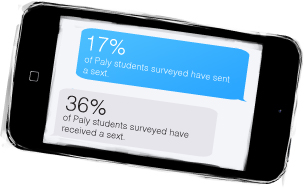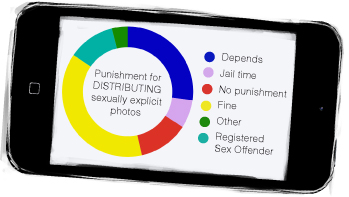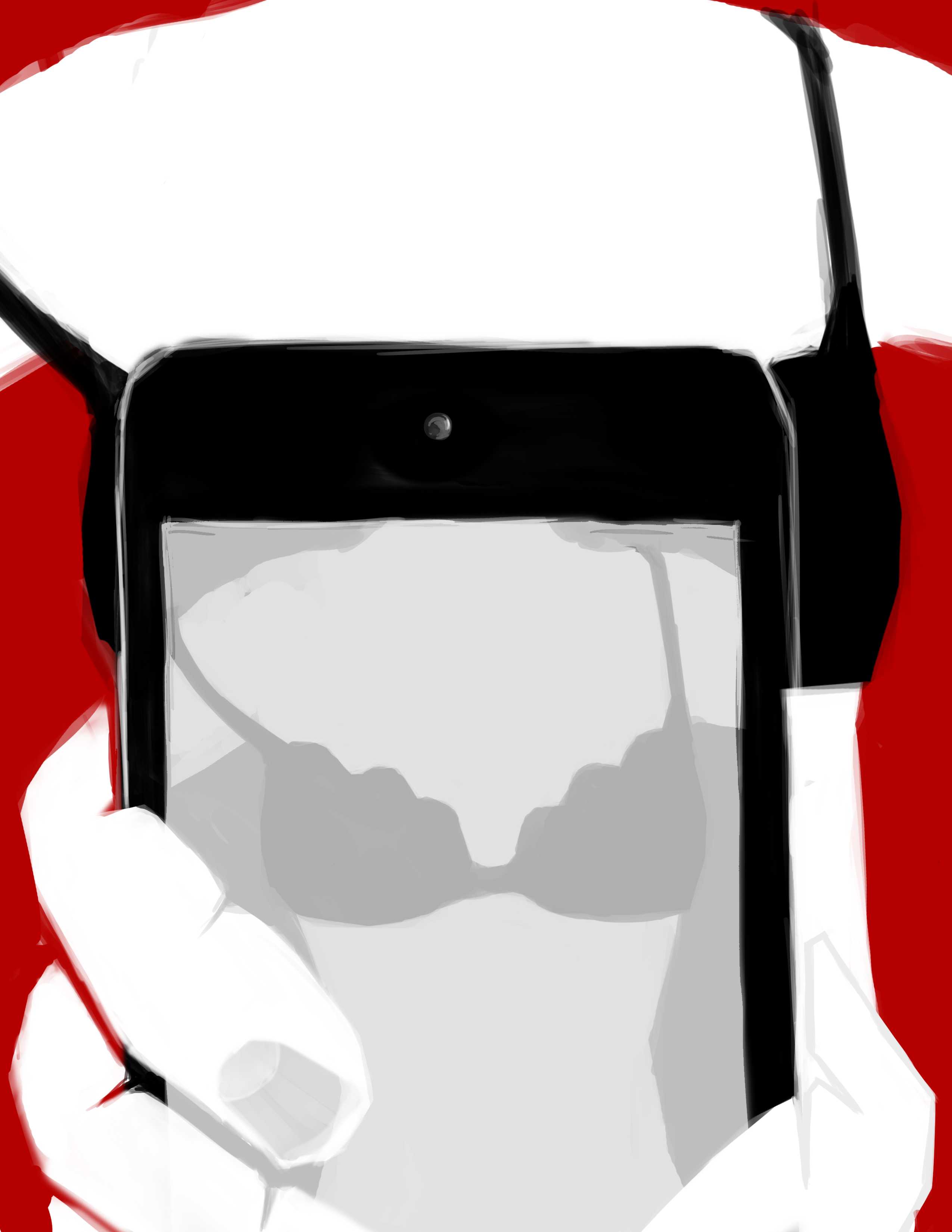The first time Mary sent a nude photo of herself, it was an accident. She had taken the photo the night before, intending to send it to an old boyfriend. She copied the photo onto her phone, but changed her mind before pasting it into the conversation. The next day, Mary attempted to paste a different message into a conversation with a different male friend, accidentally sending the photo that had been saved into her phone’s memory the night before.
Mary, a Palo Alto High School student whose name has been changed, as have the names of all students in this story to protect their identities, was not worried about having sent the accidental text. After all, he was a trusted friend and the trouble seemed over once she explained the mistake. But when she learned that the photo might have been sent to another male student she immediately confronted her friend.
 “He kept it [my sext] for a really long time and he still shows it to people to this day,” Mary says. “But I confronted him about it because that picture was an accident. It was not meant for his eyes.”
“He kept it [my sext] for a really long time and he still shows it to people to this day,” Mary says. “But I confronted him about it because that picture was an accident. It was not meant for his eyes.”
According to Mary, it is usually the male who instigates a sexting exchange or requests nude photos, and these requests appear to be occurring at a younger age than some might expect.
“I think the first time I got asked for a picture was in seventh grade,” Mary says. “I never sent one until high school, but in seventh grade my boyfriend of six months would always try to pressure me to send him pictures, and he would try to take them while I was with him. … He was trying to push me to do things I wasn’t comfortable with.”
Sexting has become an issue that has permeated youth culture in a way unique to the millennial generation. As technology becomes increasingly accessible, teens seem less and less concerned with their personal privacy when the ability to send a nude photo is only a click away.
Parents and authorities alike remain unable to find an effective means to prevent minors from sexting and, when they do sext, how to enforce consequences. Sexting is not only limited to intimate relationships since social media sites like Snaphchat allow photos to be shared with large groups.
Earlier this year, over 100 middle and high school students were reprimanded in Virginia for creating a sexting ring through Instagram, which included students between the ages of 14 and 17.
Sexting is a practice that the law deems illegal for minors to partake in, as it falls under the section of law titled Child Pornography. However, 66 percent of Paly students say they believe that teen sexting should not be considered a form of child pornography, while 40 percent say having sexually explicit pictures should receive no punishment from law enforcement.
As of 2011, sexting is an expellable offense in California due to bill SB919, which amended the California Education Code’s definition to “the sending or receiving of sexually explicit pictures or video by means of an electronic act.” The bill establishes the premises on which a student can be expelled for sexting. In order for a student to be expelled they must send the photo on school grounds, while they are going to or from school, during lunch — regardless of whether they are on campus — or during a school-sponsored activity.
A 800-person telephone survey conducted by the Pew Internet & American Life Project in 2009 found that one in six teenagers have received a sext from someone they know. The survey also revealed that teens who pay their own phone bills or have unlimited texting plans are more likely to sext than their counterparts.
Pressure to sext can come from either partner, regardless of gender, but for Mary it was not only her seventh grade boyfriend who asked her to send nude photos, the pressure to sext continued.
“I was very uncomfortable with that [being asked to sext],” Mary says, “but whenever I was dating a guy, or when a guy would hit on me, he would ask for a picture of me in my bra and stuff like that.”
Although sexting may seem most prevalent in high school, it has also become a problem at the middle school level. This past March, the San Jose Mercury News reported that a middle school boy from Brentwood was arrested for using explicit photos of a girl to used to extort sexual acts from her.
Susan Esterly, an assistant professor of psychology at Sofía University, says the prevalence of sexting cases in middle school is due to the fact that kids are trying to individuate from their child selves and embody what they see as adult actions.
“Because kids at this age are physically maturing, it can be a rough transition from childhood to adulthood, both physically and emotionally,” Esterly says. “Sexting taps into these sexual maturity dilemmas easily and less threateningly than being an actual romantic relationship.”
According to Mary, sexting in middle school often led to excess drama. Those who had their nudes distributed to others without their knowledge were often “blackmailed” and taunted by other students. Now, Mary believes that high school students are more respectful and concerned about the consequences of mass distributing others’ nude photos.
“I think that it was a lot bigger of a deal when you were younger, and with good reason,” Mary says. “I mean, I don’t think anybody knew what they were doing. I think that it did provoke a lot of behavior that I don’t think would have happened unless those pictures were sent.”
Despite what may be an environment with an increased respect for privacy, some high school students still must deal with repercussions of having their sexts distributed. According to a survey of Paly students, 12 percent indirectly receive at least half of the sexts that are sent to them, meaning the sender was not the person depicted in the photo.
“[Explicit] photos of me were distributed without my knowledge, but that was a while ago and it was more of a growing-up lesson than a sexual thing,” Paly student Phillip says. “It’s all fun and games until you get nudes leaked, and understanding what it feels like puts you in a situation where doing it to someone else is awful.”
According to Mary, such consequences can deter some from sexting or continuing to sext.
“I would definitely say that I am more self-conscious about sending pictures now, probably because I was just so naive when I was a freshman and sophomore,” Mary says.
Snapchat enables people to send photos with an artificial sense of security, as the photo is wiped from Snapchat’s servers upon reaching the recipient. However, Snapchat does not come without its own risks.
“Once I found out that people can save them [Snapchats], I stopped sending pictures like that [sexts] through Snapchat,” Mary says. “When I found out that that person was saving my Snapchats … I deleted them from his phone and made sure I never sent more like that through Snapchat. If you are tempted or get prompted to do something like that [send sexts], just try to do it in person.”
Although Mary expresses her regret for sending sexually explicit photos through Snapchat, Paly student Eric feels otherwise.
“Since I sent pictures to a person I trust, I have no worries that the photos will get out,” Eric says.
Eric began exchanging photos after beginning a relationship with a girl. His fears of the photos were non-existent due to his confidence in using Snapchat as a medium for exchanging pictures.
“We agreed to both use Snapchat so that we couldn’t save the pictures because we were both worried about them getting out,” Eric says.
Snapchat’s official policy states that it deletes a snap from its servers once every recipient has viewed the photo but is powerless to prevent others from making copies of the snaps by taking screenshots. If Snapchat is able to detect a screenshot by the recipient, they will attempt to notify the sender.
“I definitely wouldn’t exchange pictures with anyone who I wasn’t close with,” Eric says. “It [sending pictures] is not just a hook-up where you can just forget about it. Exchanging pictures sticks with a person, and even if you use Snapchat, they might take screenshots, putting you out of control of the situation, so therefore it has to be with someone you trust.”
Because of the potential consequences, responsibility is a key factor in the exchange of nude photos, not only on the part of the recipient, but also on the part of the sender.
“I personally know that if pictures that I have sent to people, if they have kept those pictures, then I am responsible if I get in trouble for that,” Mary says. “I am responsible because it was my choice to send those pictures. I knew what the consequences were when I did it.”
Yet Gunn High School student John believes consequences exist regardless of police enforcement.
“The person who sent them has to live with the fact that that person controls their entire social life for a period of time,” John says.
Although a large percentage of Paly students feel that possessing a sext should go unpunished, they say they feel that the punishment for distributing sexts should be more serious. 38 percent of those surveyed believe that students who distribute sexually explicit photos should receive a fine, while 12 percent believe that distributors should be forced to register as sex offenders, and only 15 percent believe that distribution warrants no punishment.
Regardless of the consequences, sexting has become a facet of today’s society, and it seems that it will be so for a long time.
“I treat them as a statement of how much someone would share with me,” Phillip says. “It’s a little about respect, a lot about trust and a lot about hormones.”

